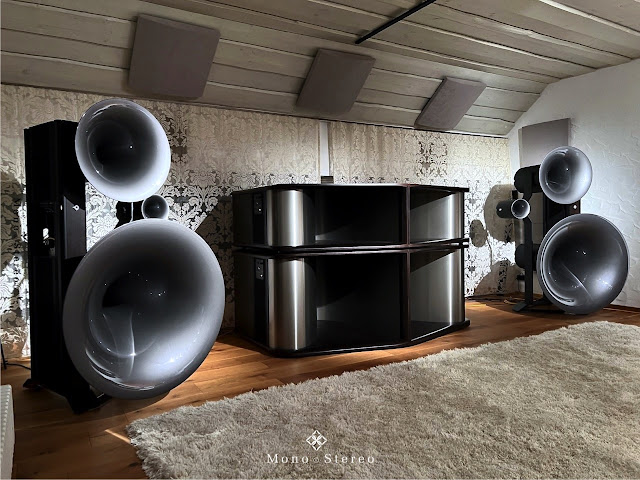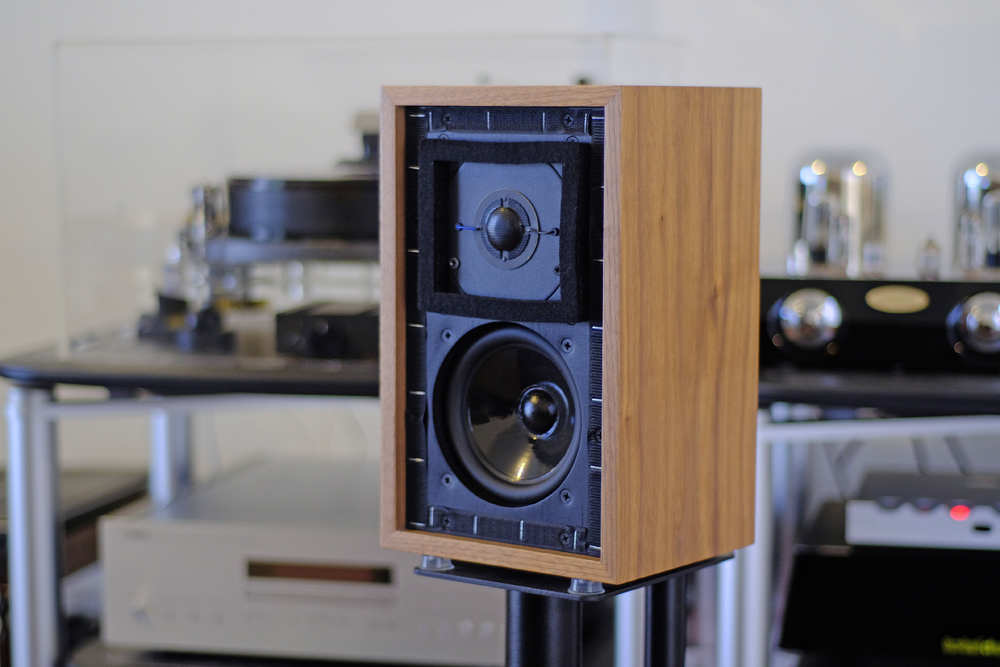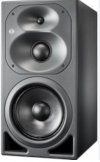This has been my experience as well.But going way back in time, it became apparent that some speakers sound more dynamic and live, while some are just plain boring and sluggish. Then looking at differences, the better tend to have high Bl, low moving mass, moderate excursion. Properties in the opposite direction to what is suitable for a driver intended for subwoofers in not too large boxes. [emphasis Duke's]
-
WANTED: Happy members who like to discuss audio and other topics related to our interest. Desire to learn and share knowledge of science required. There are many reviews of audio hardware and expert members to help answer your questions. Click here to have your audio equipment measured for free!
You are using an out of date browser. It may not display this or other websites correctly.
You should upgrade or use an alternative browser.
You should upgrade or use an alternative browser.
What makes big speakers sound "big"and smaller ones sound "small"?
- Thread starter Pearljam5000
- Start date
- Joined
- Jan 27, 2019
- Messages
- 7,336
- Likes
- 12,302
I didn't intend to imply that you were. I just thought it was an amusing riff on the "not resolving enough" corollary of the Emporer's new clothes.
EDIT:
PS As most of all y'all know -- I am a big loudspeaker kind of fellow.

and I run with a bad crowd
View attachment 346026
Oh my gosh that all looks like so much fun!
How do those "Frankenaltecs" sound? I've always wanted to hear an altec type speaker.
JeremyFife
Addicted to Fun and Learning
Enjoying this thread, but not sure I'm closer to understanding. The definition of big is still vague.
Big speakers move.more.air than small ones, no news there. At the same SPL though the same air pressure being generated at the listening point, so that's not the differentiator.
New thought: I was listening to the new album by Bill Ryder-Jones (indie rock, very nicely done) which has quite a 'lush' production - heavy use of strings, dramatic piano.
That album sounds 'big' - in comparison to other indie rock.
Same system, same speakers but a different sense of 'bigness'
Bias again? I hear strings, I "know" that takes up a lot of physical space and I therefore hear that as bigger. Is it more energy, more music in a particular frequency range - not bass though.
Some music, some productions sound 'big'. We need to isolate and explain that before worrying about speaker size.
Big speakers, playing loud in a big room will sound big. Small speakers can't match that but that doesn't answer the OP question.
Big speakers move.more.air than small ones, no news there. At the same SPL though the same air pressure being generated at the listening point, so that's not the differentiator.
New thought: I was listening to the new album by Bill Ryder-Jones (indie rock, very nicely done) which has quite a 'lush' production - heavy use of strings, dramatic piano.
That album sounds 'big' - in comparison to other indie rock.
Same system, same speakers but a different sense of 'bigness'
Bias again? I hear strings, I "know" that takes up a lot of physical space and I therefore hear that as bigger. Is it more energy, more music in a particular frequency range - not bass though.
Some music, some productions sound 'big'. We need to isolate and explain that before worrying about speaker size.
Big speakers, playing loud in a big room will sound big. Small speakers can't match that but that doesn't answer the OP question.
Easier means less distortion.Membrane area. The bigger diameter, bigger area, less excursion is needed to move the same volume of the air and it is easier for the speaker to have extended bass response. Appropriate box volume is of course assumed.
I also have a theory too:
- Bass drivers also produce midrange, but it is limited to the smaller central area of the cone, I.e. the dustcap area. On a smaller driver, the cone excursion is far greater. So the source of midrange is moving with it back & forth with low bass. This movement could affect the midrange timing or perhaps phase at times.
Could that have an effect? like a Doppler effect?
Some body correct me.
Last edited:
Pearljam5000
Master Contributor
- Joined
- Oct 12, 2020
- Messages
- 5,244
- Likes
- 5,483
- Thread Starter
- #225
Enjoying this thread, but not sure I'm closer to understanding. The definition of big is still vague.
Big speakers move.more.air than small ones, no news there. At the same SPL though the same air pressure being generated at the listening point, so that's not the differentiator.
New thought: I was listening to the new album by Bill Ryder-Jones (indie rock, very nicely done) which has quite a 'lush' production - heavy use of strings, dramatic piano.
That album sounds 'big' - in comparison to other indie rock.
Same system, same speakers but a different sense of 'bigness'
Bias again? I hear strings, I "know" that takes up a lot of physical space and I therefore hear that as bigger. Is it more energy, more music in a particular frequency range - not bass though.
Some music, some productions sound 'big'. We need to isolate and explain that before worrying about speaker size.
Big speakers, playing loud in a big room will sound big. Small speakers can't match that but that doesn't answer the OP question.
I guess the ultimate test is to play the same song at the same SPL on 8010 and 8361 and to see if the 8010 sounds smaller at the same volume.
My guess(from my experience )is the 8010 will sound smaller ..
Why ? I also don't know 100% why
mhardy6647
Grand Contributor
- Joined
- Dec 12, 2019
- Messages
- 11,412
- Likes
- 24,773
Oh, you must do so some time! They sound great, very soft or very loud. It is disorienting to listen to the fade-out on a recording and notice essentially no change in clarity or timbre as the volume eases down towards the baseline.Oh my gosh that all looks like so much fun!
How do those "Frankenaltecs" sound? I've always wanted to hear an altec type speaker.
As Gary Kaufman (caretaker of those A5s in the other photo -- one doesn't really own Altecs, as they will outlive any mortal "owner") likes to call it effortlessness. The effortlessness of the Altecs is noteworthy, and really satisfying.
Either that, or go whole hog and listen to some big RCA theater horns all loaded with electrodynamic drivers. Dig through some 2023 Stereophiles and you'll see the specific loudspeakers to which I refer. They're really something, as is the purpose-built space in which they dwell. Very different undertaking than that poor guy in Virginia who lit up the internet (indirectly) thanks to his kids, Youtube, and the WaPo.
You have not heard dynamics and sense of scale such as this class of loudspeakers can achieve.
C'mon by sometime!
- Joined
- Jan 27, 2019
- Messages
- 7,336
- Likes
- 12,302
Think these speakers would sound "big?"
(I love some of the Japanese audiophile videos on this site):
(I love some of the Japanese audiophile videos on this site):
Women. Yes I know it's "sexist" It's also very true "Those Bose Acoustimass sound so much bigger than those Klipschorns you had before we were married" Not all people named Amir are good people (-:Sorry for the stupid question but
Bigger speakers also sound bigger to me than smaller ones even at the same volume.
I've been told this is not correct and impossible but i still feel that way, and also other people do because I read the cliche of "these speaekrs sound much bigger than they are" Pretty much everywhere.
What is the cause of this phenomenon?
Keith_W
Major Contributor
This is only speculation on my part, because I have never seen anybody discuss this. But I think the size of the wavefront is what makes a big speaker sound big. I don't know how many of you have had the chance to hear these:

... and compare them to these:

I heard them back to back in the same room. Even when adjusted to the same SPL, the Avantgardes sounded huge. It literally sounds like a "wall of sound". So they do some things like reproduce the sense of scale very well - e.g. you can feel a pipe organ. But they get beaten by the little Rogers when it comes to imaging. The Avantgardes makes the singer sound like she has a 6 foot wide mouth, whereas the Rogers has a more believable image.
Polar plots and directivity charts express the measurement in degrees, so a small speaker with a 30deg cone of radiation looks the same as a huge speaker with a 30deg cone of radiation. But they most certainly do not sound the same. I am pretty sure "the size of the wavefront" can be measured, but we would need invent a new measurement standard for it. Maybe I am being ignorant here, because (as someone told me in another forum), "if something so obvious has occurred to you, be assured that it has already been considered" which is a polite way of saying "there are smarter people than you out there"

... and compare them to these:

I heard them back to back in the same room. Even when adjusted to the same SPL, the Avantgardes sounded huge. It literally sounds like a "wall of sound". So they do some things like reproduce the sense of scale very well - e.g. you can feel a pipe organ. But they get beaten by the little Rogers when it comes to imaging. The Avantgardes makes the singer sound like she has a 6 foot wide mouth, whereas the Rogers has a more believable image.
Polar plots and directivity charts express the measurement in degrees, so a small speaker with a 30deg cone of radiation looks the same as a huge speaker with a 30deg cone of radiation. But they most certainly do not sound the same. I am pretty sure "the size of the wavefront" can be measured, but we would need invent a new measurement standard for it. Maybe I am being ignorant here, because (as someone told me in another forum), "if something so obvious has occurred to you, be assured that it has already been considered" which is a polite way of saying "there are smarter people than you out there"
Last edited:
- Joined
- Jan 27, 2019
- Messages
- 7,336
- Likes
- 12,302
About 9 minutes in they start playing these bad boys....
OMG, what a pad! What a system! Very jealous. I'd love to hear those (they have a very "live" sound transmitting through youtube).
Pearljam5000
Master Contributor
- Joined
- Oct 12, 2020
- Messages
- 5,244
- Likes
- 5,483
- Thread Starter
- #232
It's similar to this one

D
Deleted member 48726
Guest
This is only speculation on my part, because I have never seen anybody discuss this. But I think the size of the wavefront is what makes a big speaker sound big. I don't know how many of you have had the chance to hear these:
...
Polar plots and directivity charts express the measurement in degrees, so a small speaker with a 30deg cone of radiation looks the same as a huge speaker with a 30deg cone of radiation. But they most certainly do not sound the same. I am pretty sure "the size of the wavefront" can be measured, but we would need invent a new measurement standard for it. Maybe I am being ignorant here, because (as Dr. Uli told me in another forum), "if something so obvious has occurred to you, be assured that it has already been considered" which is a polite way of saying "there are smarter people than you out there"
That's interesting. And new to me. It sounds somewhat logical to me as I imagine waves at sea vs. waves in a pool.
Oh, and that last sentence rubs me the wrong way and comes out as a very posh way of saying "I'm smarter than you". Sorry, had to get it out of my system. In my experience even the most decorated engineers make wrong assumptions and decisions. Humans make mistakes.
D
Deleted member 48726
Guest
Oh boy! I bet these got that "slam" I like..It's similar to this one View attachment 346107
This is where it gets tricky. Always some sort of compromise, it seems, for sound. You want it large, then everything is large. You want it precise, then it also becomes very small..But they get beaten by the little Rogers when it comes to imaging. The Avantgardes makes the singer sound like she has a 6 foot wide mouth, whereas the Rogers has a more believable image.
The reason for those differences lies in the radiation, very different. The larger horns have (sort of..) directivity across a wide frequency range, and the wavefront is much larger before it can interact with reflections from room surfaces. Similar properties are found in large line sources, such as larger panel speakers, they sound big.
pogo
Major Contributor
- Joined
- Sep 4, 2020
- Messages
- 1,306
- Likes
- 424
I don't know how many of you have had the chance to hear these:

I have had the chance to hear these
And the effect of switching from Accuphase to their own current power amplifiers iTRON was very interesting.
Last edited:
benanders
Senior Member
About 9 minutes in they start playing these bad boys....
When I see something like this setup and imagine complaints about big speakers covering up that artistic front wall-work, I think about how much more offensive glossy flatscreens look among the mix, despite general acceptance as “standard” for living spaces.
-100 pts for oversized coffee table bogarting the slow-dance floor
+100 pts for the coffee table dachshund matching the McAmp backlighting color.
What a fun place.
RobL
Addicted to Fun and Learning
- Joined
- Mar 4, 2021
- Messages
- 937
- Likes
- 1,564
I did find this study that found that “Overall, the spatial extent on a line source may influence the perception of it’s width.”. So maybe a speaker constructed as such:

would sound “bigger” than a speaker constructed like this:

One participants observations didn’t correlated well though, so maybe not everyone is equally apt at discerning source width? The other thing is that wouldn’t the apparent source width of a pair of speaker be the distance between them which would cancel any perception of actual speaker width?

would sound “bigger” than a speaker constructed like this:

One participants observations didn’t correlated well though, so maybe not everyone is equally apt at discerning source width? The other thing is that wouldn’t the apparent source width of a pair of speaker be the distance between them which would cancel any perception of actual speaker width?
Sokel
Master Contributor
- Joined
- Sep 8, 2021
- Messages
- 6,157
- Likes
- 6,251
Maybe also the distance between them,as the bigger ones are usual further away from each other?I did find this study that found that “Overall, the spatial extent on a line source may influence the perception of it’s width.”. So maybe a speaker constructed as such:
View attachment 346263
would sound “bigger” than a speaker constructed like this:
View attachment 346264
One participants observations didn’t correlated well though, so maybe not everyone is equally apt at discerning source width? The other thing is that wouldn’t the apparent source width of a pair of speaker be the distance between them which would cancel any perception of actual speaker width?
Thing is though that the big sound big in all three dimensions and particularly the depth is one of their strong elements.
Has anything to do with their bigger and deeper cabinets?
benanders
Senior Member
Outliers and variance highly likely, depending on sample size and other parameters.…
One participants observations didn’t correlated well though, so maybe not everyone is equally apt at discerning source width?
Interaction effects of room / boundaries / reflections make my knee jerk reaction a “not necessarily”…The other thing is that wouldn’t the apparent source width of a pair of speaker be the distance between them which would cancel any perception of actual speaker width?
But I need to read that paper tomorrow. Thank you for posting the link @RobL .
Similar threads
- Replies
- 41
- Views
- 2K
- Replies
- 34
- Views
- 4K
- Replies
- 46
- Views
- 4K
- Replies
- 9
- Views
- 2K
